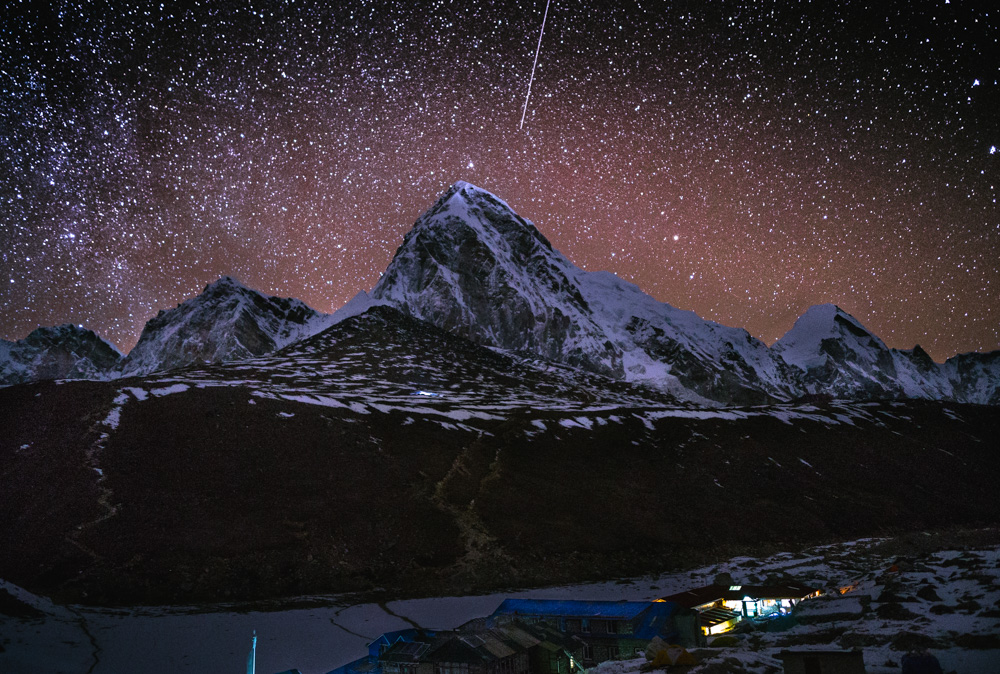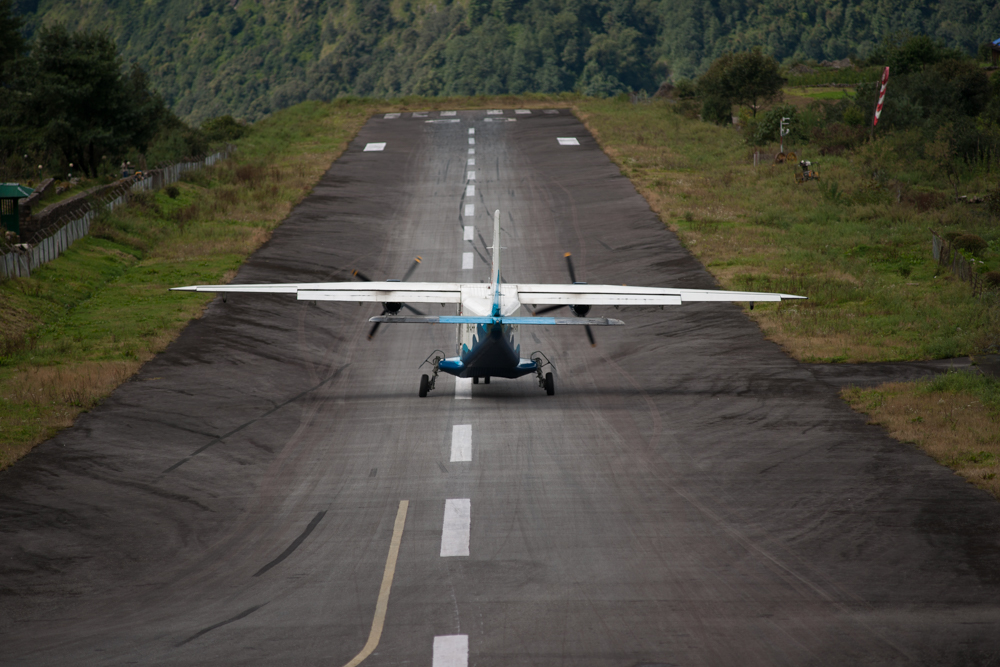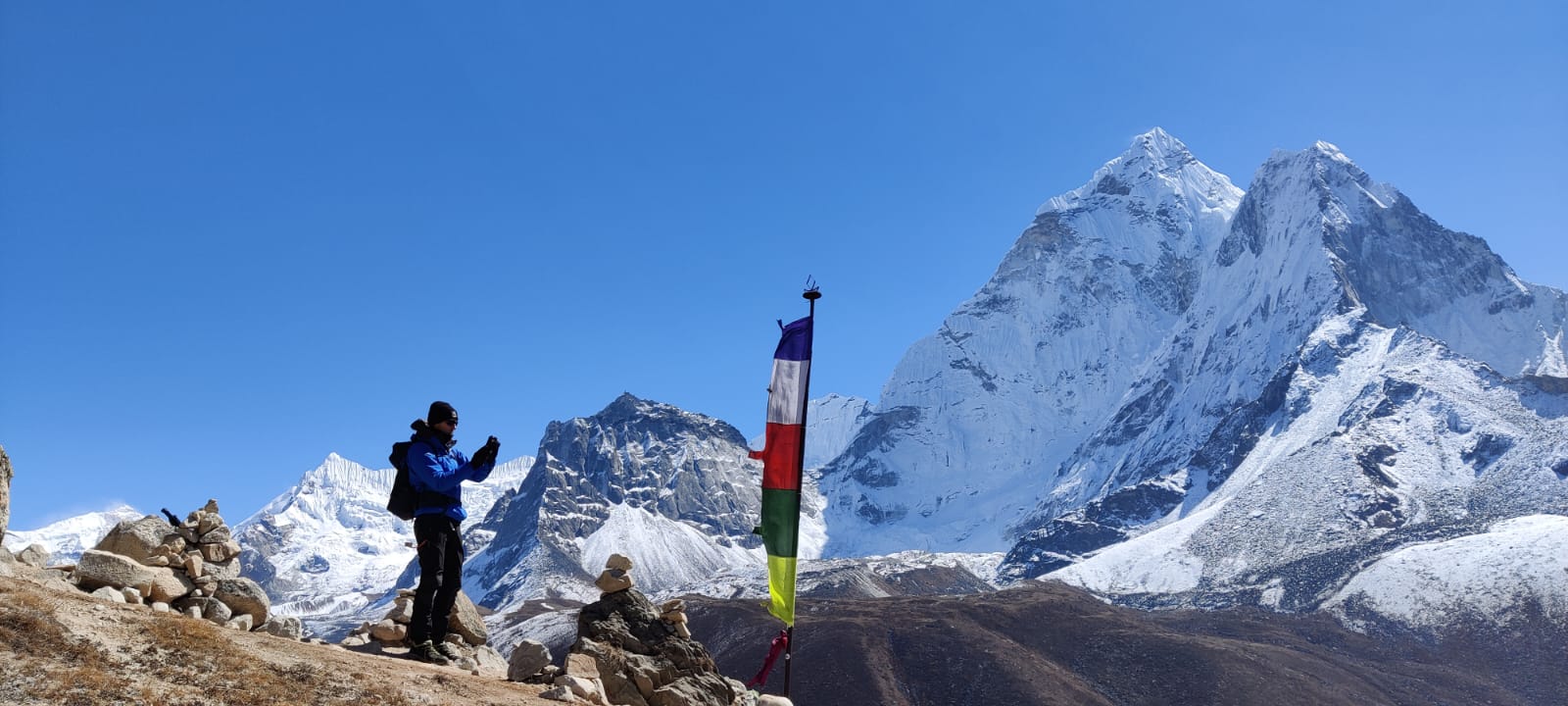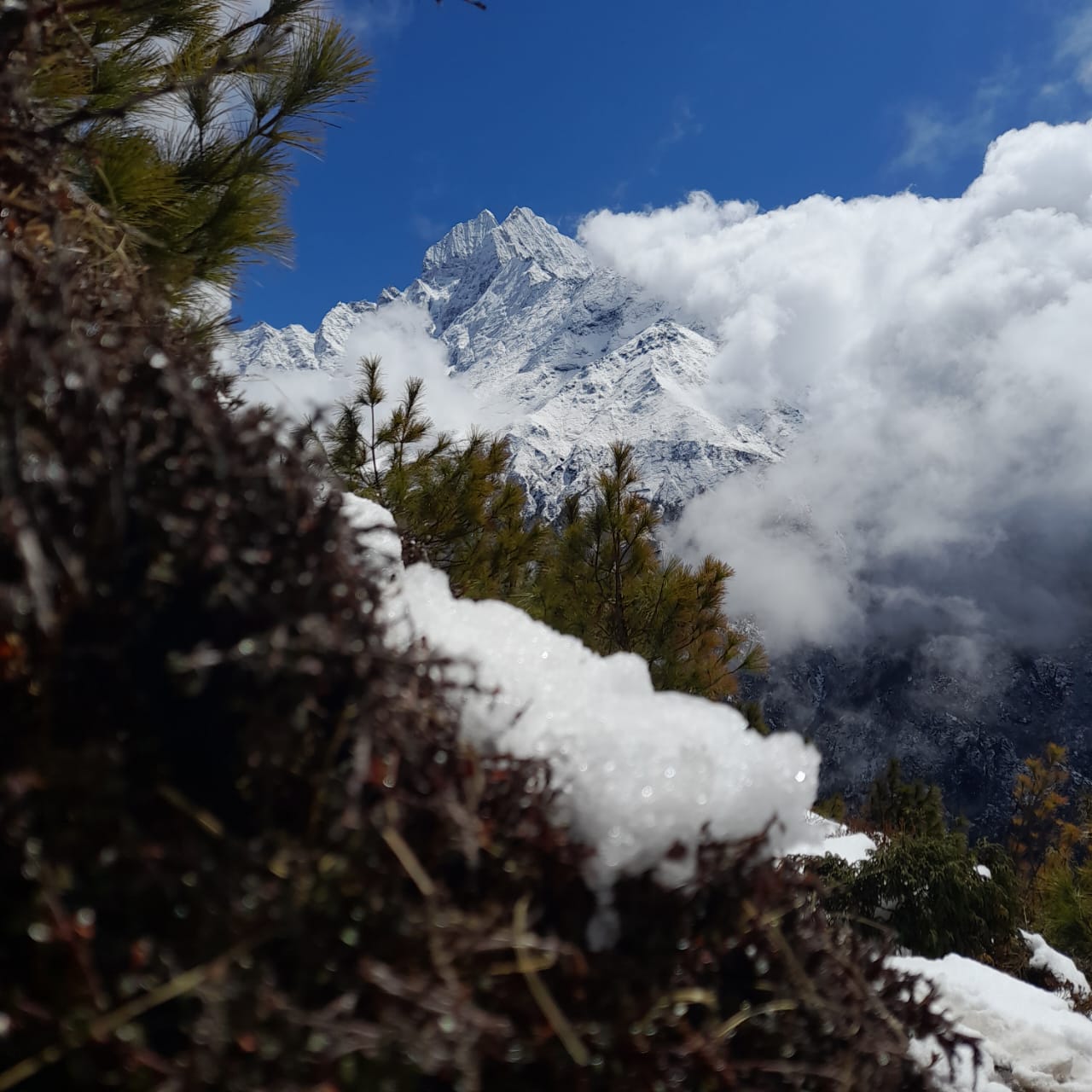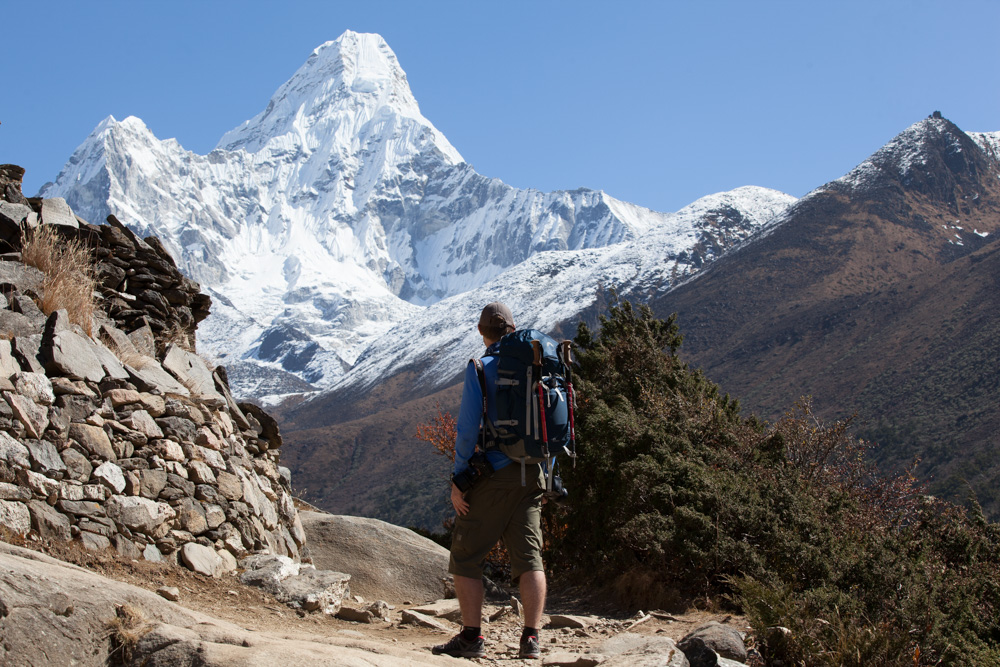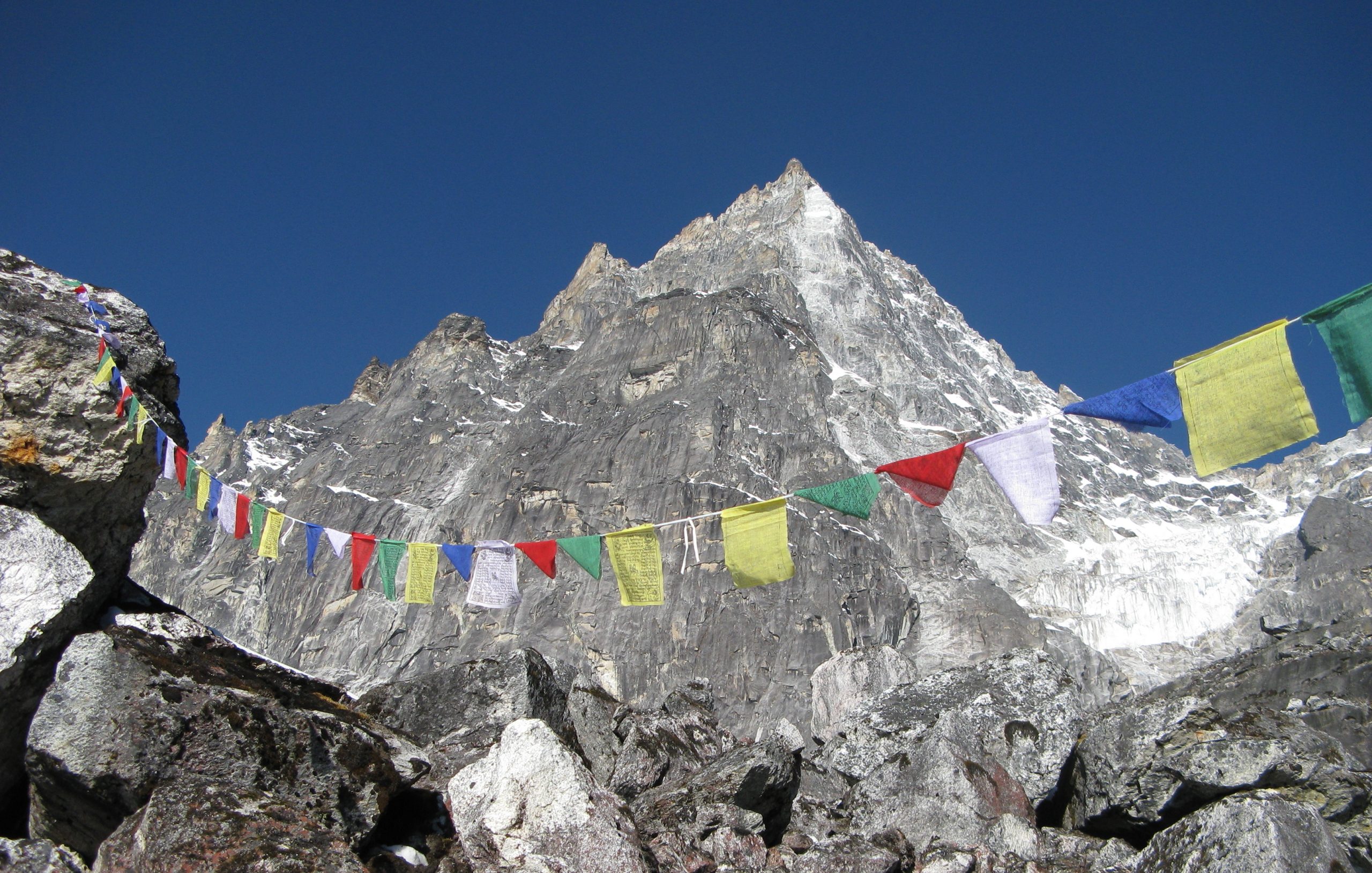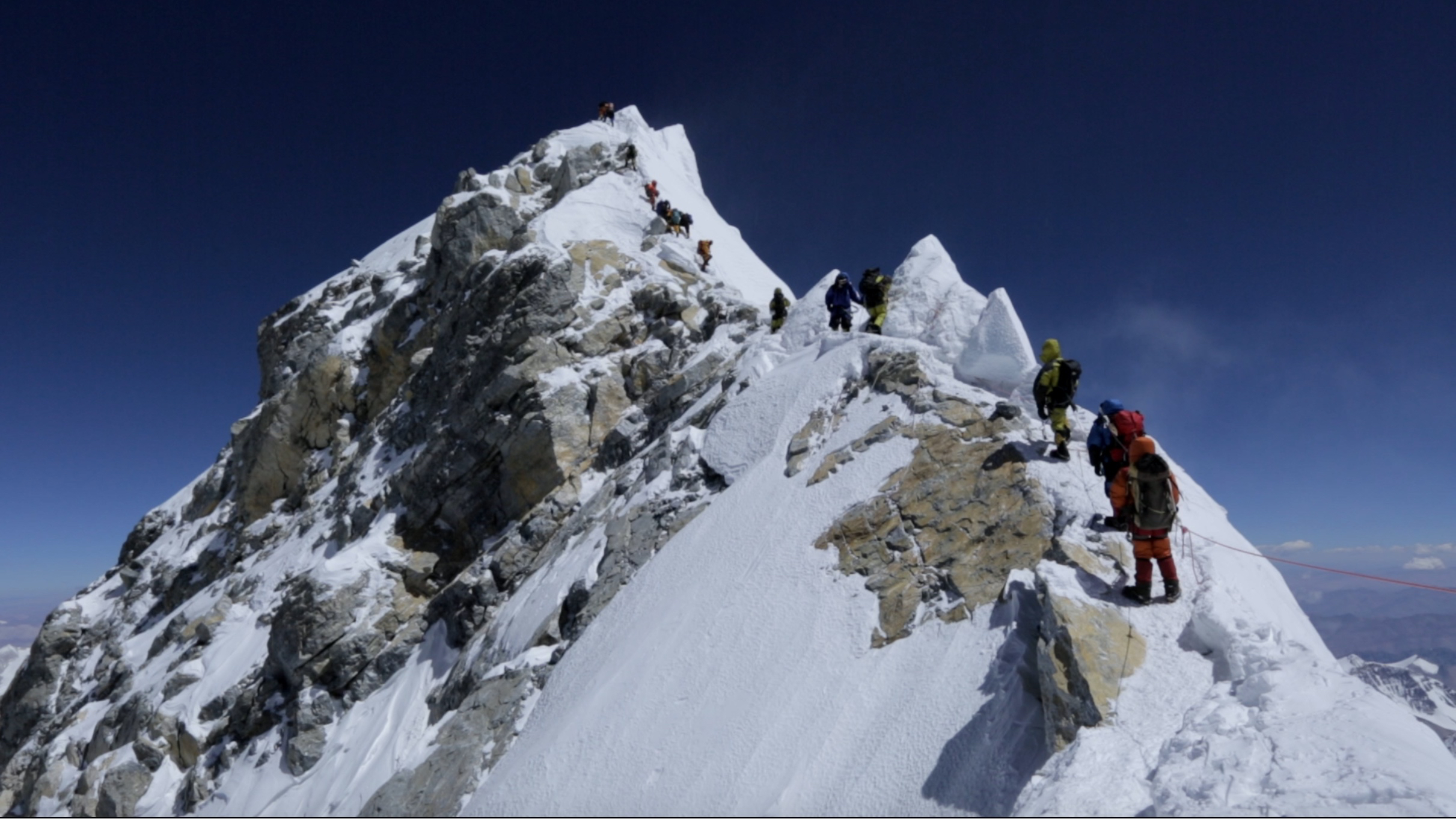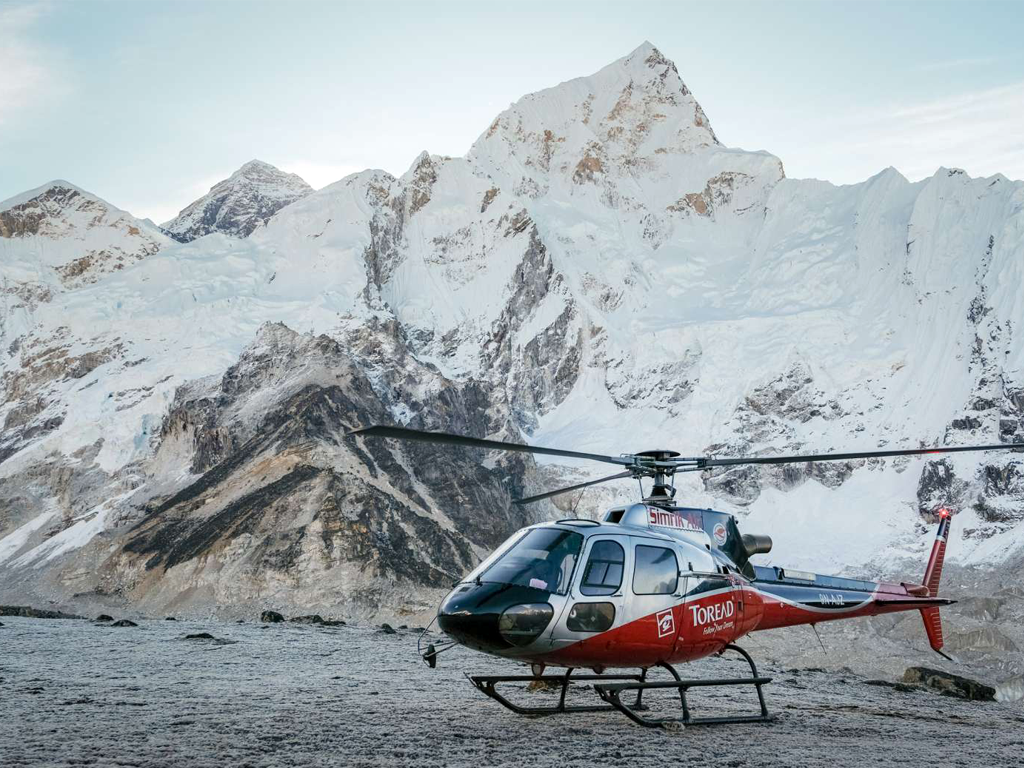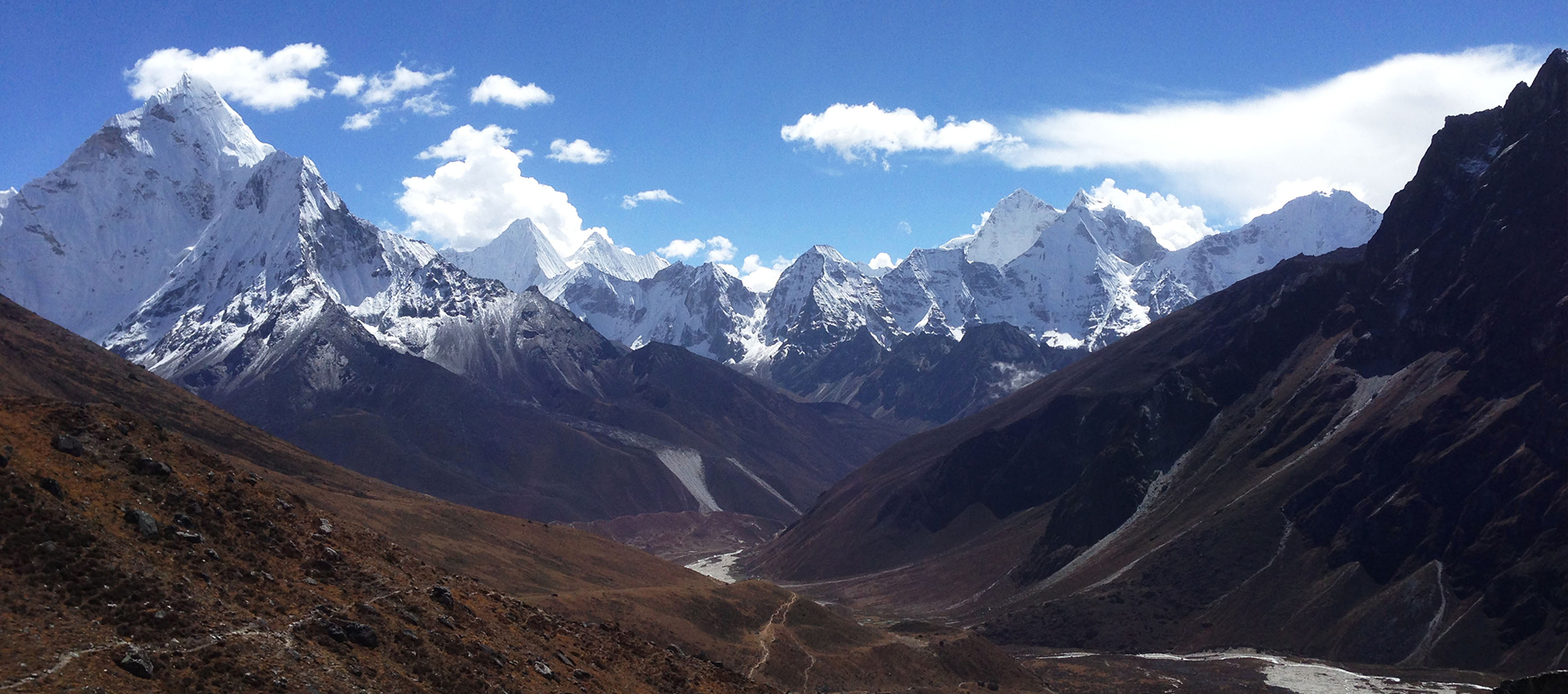
The Everest Base Camp Trek
World's highest peak Mt. Everest (29,029 ft/ 8,848.68m)
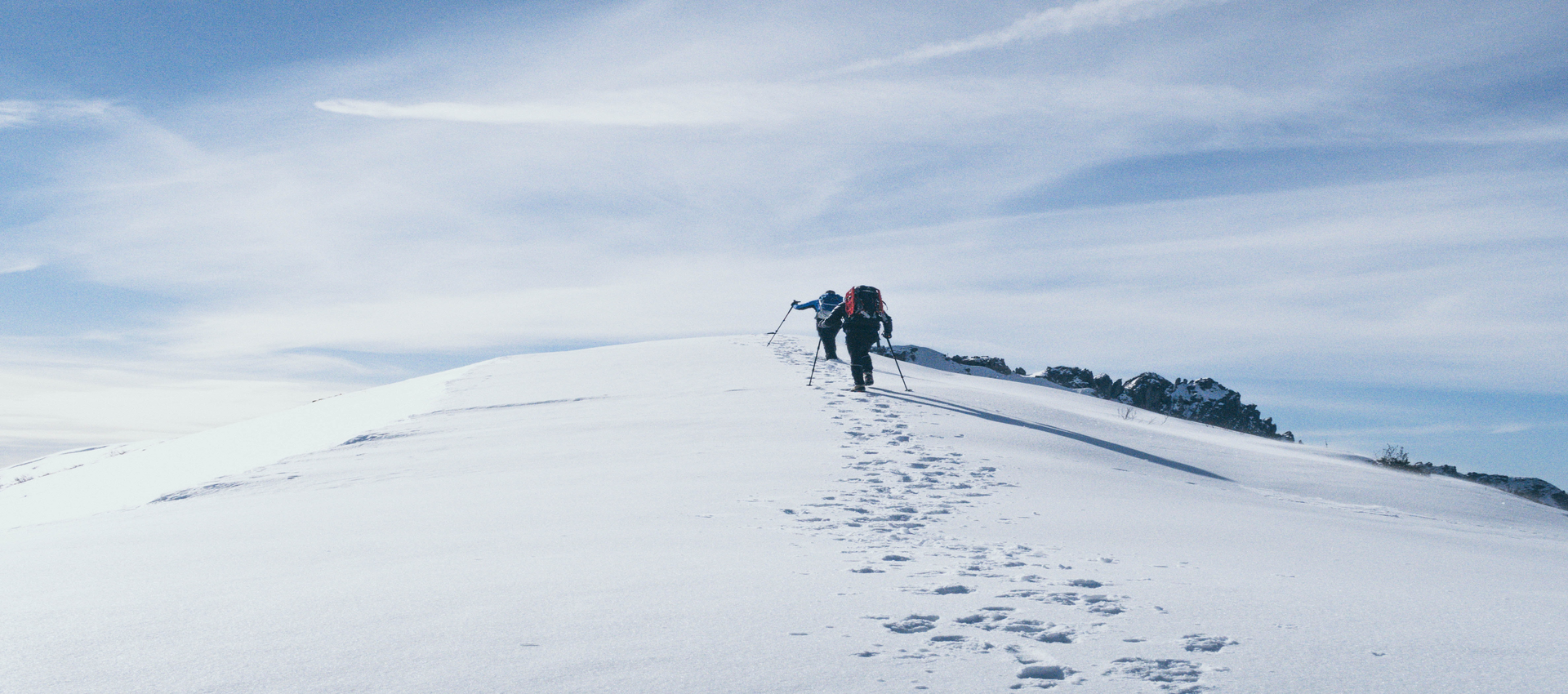
The Everest Base Camp Trek
World's highest peak Mt. Everest (29,029 ft/ 8,848.68m)
- Home /
- Nepal /
- Trekking & Hiking /
- Everest Region /
- The Everest Base Camp Trek
The Everest region in Nepal is more than just climbing and trekking, it is a life-changing experience and some see it as a journey close to achieving Nirvana. Located in the northeastern province of Nepal, this region is in a world of its own with vast glaciers, icefalls, the highest mountains, deep valleys, precarious settlements, and hardy people challenging the harshest conditions thrown at them by nature in the thin air of high altitude.
Added: Passing through legendary Sherpa villages, the trek is a mix of deep cultural and spiritual experiences and physical challenges that test your strength and endurance. Buddhist lamas, monks and nuns led by Rinpoches (reincarnate at mas) serve the predominantly Sherpa communities from their gompas.
Added: The journey to Everest or Everest Base Camp begins with a dramatic flight from Kathmandu to Lukla, after which you hike up the Everest region to reach your destination in the Himalayas. However, for die-hard lovers of trekking, there is another switchback starting from Jiri through the mid-hills of Solu, an ethnically diverse section of the trek rich.
Added: The Everest trek involves a tremendous amount of up-and-down walking. After considerable uphill climbing, it will come to almost 5,364m / 17,593 ft. of elevation to Everest Base Camp. The Nepal Himalayas are best seen on this trek as one traces the main route through the Khumbu region from the Sherpa town of Namche Bazaar. The trekkers get a close view of the world’s greater mountains such as Mt. Everest (8,848m) and others mountains like Lhotse, Nuptse, Thamserku, and Tawache.
Added: The Everest region has been valued as the key to the evolutionary history of the Earth and is also a habitat for some rare and endangered species like the snow leopard, red panda, Himalayan black bear, musk deer and Himalayan wolves.
Route Map
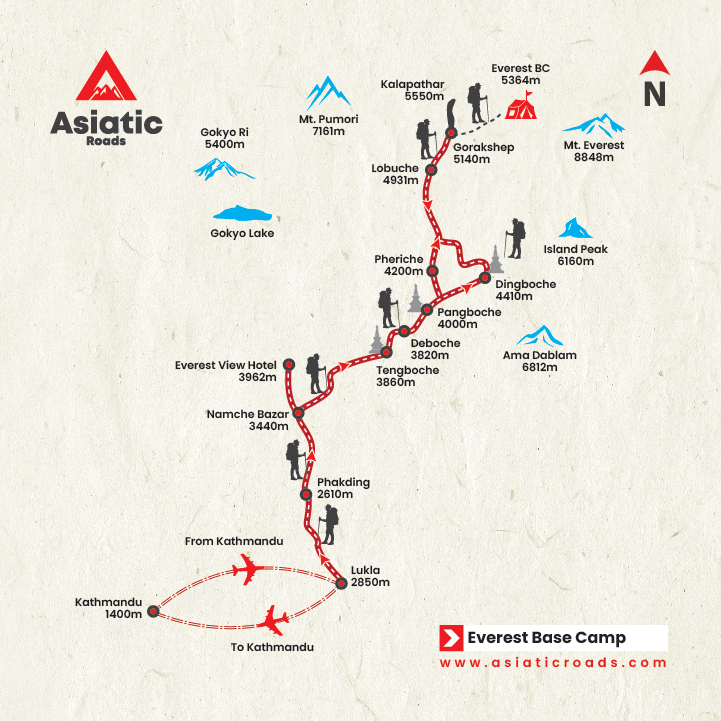
Itinerary In Detail
-
Day 01: Arrival in Kathmandu (1,400 m / 4,592 ft.)
Upon arrival in Katmandu’s Tribhuvan International Airport, meet, assist and transfer to hotel. After welcome refreshments and room check in the hotel, there will be a short briefing and orientation about the trip. Rest of the day is free for leisure.
Overnight at hotel.
-
Day 02: Trekking preparation and sightseeing day in Kathmandu.
Am: After breakfast, proceed for a sightseeing tour of Kathmandu City. It includes visit to the Bouddhanath Stupa, the biggest stupa in Nepal. This is also called by many as Khasti Chitya, is one of the oldest stupas in the country. The stupa, a well-known Buddhist pilgrimage site, is included in World Heritage Cultural site list by UNESCO. With diameter of about 100m and 40m height, Buddhanath holds its place among the largest Stupa in the world!
Later proceed to Pashupatinath Temple, with its astonishing architectural beauty, stands as a symbol of faith, religion, culture and tradition. Regarded as the most sacred temple of Hindu Lord Shiva in the world, Pashupatinath Temple’s existence dates back to 400 A.D. The richly-ornamented pagoda houses the sacred linga or phallic symbol of Lord Shiva. Thousands of pilgrims from all over the world come to pay homage to this temple that is also known as ‘The Temple of Living Beings’, which is listed UNESCO world heritage Site. Later transfer back to hotel for some rest and refreshment.
After visiting Pashupatinath Temple proceed for sightseeing tour of Kathmandu Durbar Square. Listed as one of the eight Cultural World Heritage site by UNESCO, Kathmandu Durbar Square is a cluster of ancient temples, palaces, courtyards and streets that date back to the 12th and 18th centuries. The square is known to be the social, religious and urban focal point of the Capital City. The Palace Complex was the royal Nepalese residence until the 19th century and was the site of important ceremonies, such as the coronation of the Nepalese monarch. We can also visit Temple of Living Goddess “Kumari”, and the Kasthamandap Temple, which is believed to be constructed from the wood of a single tree from which Kathmandu derives its name
Pm: Free for trek preparation – briefing and orientation etc.
Eve: Traditional Welcome dinner followed by Nepali Cultural program.
Overnight at hotel.
-
Day 03: Fly To Lukla & start Trek to Phakding (2,652m / 8,700 ft.) – 3 hrs.
Early morning transfer to the airport to fly to Lukla (2880m). This 45-minute flight provides a magnificent entry to the trek. It highlights the snowline of the Himalayan Range in the north and the rugged landing at the Lukla airport, which is said to be one of the most spectacular flights in the world. Upon arrival the guide will arrange the porters at the nearby lodge. During this break, the guests are welcome to explore this bustling town on top of a hill with rows of houses, hotels and shops lining both sides of the traditional cobbled street.
The trek starts by following the trail leading to the northwest direction through the narrow street, which immediately descends from the end of the village on a trail through the open hillside. The trail is well defined and there are many shops and lodges catering to the trekkers. This day’s trek is an easy one and ultimately descends to the river at Phakding (2,652m).
Dinner and overnight at teahouse lodge.
-
Day 04: Trek to Namche Bazaar (3,447m / 11,300 ft) – 5~6 Hrs
Leave the main village and the follow the trail on the left bank of the Dudh Kosi River. It is a pleasant walk for the first half of the day as one passes through agricultural countryside and small wayside villages. Just before lunch, there is a steep climb of about 20 minutes to arrive at Monjo for Lunch. After lunch, trek up to the check post to check the permits and enter into the Sagarmatha National Park. Descend for 10 minute and then cross a suspension bridge to arrive at Jorsale (2,800m). Pass through several small villages and beautiful pine forest. This is a busy trail with plenty of human interest.
Our first good views are of west ridge of Kusum Kangru (6,339m). Follow the Dudh Kosi River, crossing a rickety suspension bridge, which is in a dilapidated condition, and then slowly climb up a very steep trail to Namche Bazaar. Near half waypoint, we enjoy our first views of Mt. Everest (8,848m), Nuptse (7,879m) and Lhotse (8,383m) – the big three. The climb is for nearly 3 hours as one gain in altitude making breathing difficult due to rarified air. Arrive at a gate with a sign saying, “Welcome to Namche Bazaar” but it is very misleading as it takes another 20 minutes to arrive at the main town.
This prosperous town is the largest in Khumbu. Mt. Thamserku (6,648 m) and Kwangde Ri (6,624 m) loom along the east and west of the village. The sacred mountain Khumbila (5,707 m) dominates the skyline along the west.
Dinner and overnight at teahouse lodge.
-
Day 05: Rest & acclimatization Hike to Shyangboche Everest View Hotel (3,880 m / 12,727 ft.) - 3/4 hours.
After breakfast start climb to famed Hotel Everest View hotel in Shyangboche at an altitude of 3,880m. It is a steep climb through the rocky train until we reach to Shyangboche Airstrip. From here is it fairly gentle climb mostly through Rhododendron, Pine and Juniper forest. As we slowly gain the altitude we can experience dramatic changes in the vegetation.
Once we reach to the summit of Shyangboche we can witness the breathtaking view giant snowcapped Mountains including Mt. Everest (8,848m), Lhotse (8,516m), Thamserku (6,648 m), Kwangde Ri (6,624 m), Khumbela (5,761 m) & beautiful Mt. Amadablam (6,812 m) any many others.
From here it is a level walk to famed Everest View Hotel. Along the way we can see many Yaks grazing around. We will spend good time at Hotel Everest View having Tea / Coffee while enjoying the panoramic view snowcapped Mountain. Later start descends down to Namche Bazaar for lunch. In the afternoon you are free for a rest or stroll around colorful Namche Bazaar. There are several coffee shops, bakery, book shops and adventure gears shops etc.
Dinner and overnight at teahouse lodge.
-
Day 06: Trek to Devouche via Thyangboche Monastery (3,800 m / 12,464 ft) – 7 Hrs.
Walk to the checkpoint to show the permits. Then walk uphill for a short period to reach a huge prayer stone from where the path straightens and we get great views of some of the Himalayan ranges. Later as we walk we descend through the rhododendron forest, watching for the blood pheasant and Imphayan pheasant in the undergrowth. As we reach the valley there is Dudh Kosi River where we stop for a lunch at Phunki Thanga (3,200m), next to several large water driven prayer wheels. The afternoon is spent climbing slowly on a steep trail to the Thyangboche Monastery. Thyangboche lies at the base of Kangtega and is a classic setting with superb views backs up the valley to the Ama Dablam, and the Everest poking its southwest face over the huge ridgeline linking Nuptse and Lhotse. The Thyangboche Monastery is one of the most important monasteries of the Khumbu Region and the late afternoon can be spent visiting this ancient Monastery. It is the traditional place where all Everest Expeditions receive their blessings as they walk in towards the base camp. After visiting Thyangboche Monastery a short, steep and muddy descent to Devouche through theforest of briches, conifers and rhododendrons.
Dinner and overnight at teahouse lodge.
-
Day 07: Trek to Dingboche (4350 m. /14,880 ft.) - 5 hrs.
After breakfast, set out on the trail with a short, steep and muddy descent through a forest of birch, conifer and rhododendron to the meadows of Devouche. Continue on a level trail through forests to arrive at a suspension bridge high above the fast flowing Dudh Kosi River with fine views of Mt. Amadablam. Cross the suspension bridge and climb for another 20 minutes to arrive at a resting place. Continue to climb to a pass and then there is a gentler walk to the village of Pangboche (3985m), which also has a monastery. The monastery lies more on the route to Phortse and is not easily reached from the lower trail and for those who desire to visit the monastery, the trail bifurcates just before the village after the pass and a hard half hour of climb up the ridge brings one to this fabled monastery. At the monastery is housed the Scalp of the Yeti which traveled the world in the 60’s.
After lunch, pass through this village and take the right hand trail through the front yard of a few herders’ huts, over a stonewall. The landscape becomes very interesting as the vista opens before us and we can see the river flowing far down below as we take the trail that has been cut out along the sheer cliffs of rocks. A further, 40 minutes of walking brings us to the upper Pangboche Village from where there is a very steep climb to the ridge before descending to Khumbu Khola. Cross the bridge on a wooden bridge and from the bridge it is a 20-minute walk, usually in fierce winds to the valley of Dingboche.
Dinner and Overnight at Dingboche.
-
Day 08: Dingboche – acclimatization day.
As per the study on high altitude sickness, it has been found that most of the people suffer or show signs of Acute Mountain Sickness (AMS) from the altitude of 14,000 ft. Thus it is highly recommended to have a rest day to acclimatize at this altitude before starting an ascent.
Dinner and overnight at Dingboche.
-
Day 09: Trek to Lobuche (4,931 m / 16,173 ft) – 5 Hrs
An ill- defined track traverse across the open landscape with a short steep ascent to arrive at a ridge to join the trail coming up from Preriche & Cho la pass on the left.
On the way you can watch the beautiful view of the Mt. Cholatese (6,442m) back on the Westside of the route and Mt. Amadablam to the rear. After arrival at the ridge, descend, for about ten minutes, cross a bridge and arrive at Thugla for a short break.
After Thugla, there is a very steep ascent for about one hour to the ridge where there is a Sherpa memorial in remembrance to those brave mountaineers who died during Expeditions.
Travel along the jumbled moraines and scattered rocks passing by the memorials of Rob Hall and Yasuko Namba and others who perished during the Mt. Everest disaster of 1996. The memorial chortens dots the skyline facing the mountains and overlooking the valley below. Further on the trail leads to the terminal moraine of the Khumbu Glacier with views of Pumori or Widow’s Peak in the foreground. The stark and the rugged beauty create almost a moonscape. The teahouse at Lobuche is reached for lunch, after another hour of steady trekking through the moraine and is situated in a windswept valley with the views of the Tawatse (6,501m) and Nuptse (7,855m).
Dinner and overnight at teahouse lodge.
-
Day 10: Trek to Gorakshep (5,160m) & climb Kala Patthar for sunset view (5,545 m) - 7 Hrs.
From Lobuche, a short climb brings one to another valley. Travel along the Khumbu Glacier through the jumbled moraines and scattered rocks. The trail continues to slowly contour on the open landscape through an ablation and after about an hour, there is a steep ascent for about 20 minutes. Climb slowly to a ridge and then continue on a trail of rocks caused by rockslides. On a clear day Mt. Everest can be seen looming behind Nuptse. Arrive at the ridge above Gorakshep and then descend to Gorakshep, a settlement with 2 teahouses to stay overnight. This was the base camp for the 1952 Swiss Everest expedition. In 1953 A.D. the British Everest expedition called this “lake camp’. Gork Shep or “graveyard of the crows” has a small lake that is usually frozen and several monuments to climbers who have died during various Everest expeditions. The carved stone in memory of Jake Britenbach, US expedition and the monument of Indian Ambassador H. Dayal, who died during a visit to the Everest Base Camp after the 1965 A.D, Indian expedition, are northeast of the lake. – 3 Hours.
After lunch at Gorakshep keep your bag – packs in the lodge and take the left-hand side trail and head straight up the hill to Kala Pattar (5,545m) for views of Mt. Everest. The trek up to the top is an arduous one and takes about an hour and half to two to reach it. The afternoon is the best time to view Mt. Everest from this vantage point as the sun is behind the observer and directly on the mountains in front. The climb to the Kala Pattar though tough, is well worth it as the views from here are breathtaking. The giants of the earth are all around Pumori (7,145m), Everest (8,848m), and China’s peak Changtse (7,553m), Nuptse (7,855m), Lhotse (8,516m), Ama Dablam and many others. Later return to Gorakshep.
Dinner and overnight at teahouse lodge.
-
Day 11: Trek to Base Camp (5360m / 18,000 ft.) & back to Pheriche or Pangboche (3,985 m / 13,070 ft.) –8 Hrs.
The trip to base camp, while fascinating, is not spectacular as the ascent of Kala Pattar because there is no view of Everest itself from the base camp. Mt. Lhotse and Mt. Nuptse, which loom over the Base Camp, shades the view of Everest. The trail continues on a ridge from where a small glimpse of Mt. Everest can be seen. At the end of the ridge, a scrabbling descent leads to the entry into Khumbu Glacier. The trail through the glacier is an interesting one in that one can actually feel as if one is inside a fridge with the cold seeping from all sides. The Everest Base Camp is also the site for the base camp for Lhotse and Nuptse. It is not actually a specific site as various expeditions have elected different locations for a semi-permanent camp during their assault on the mountains. Some of the sites that expeditions have used, as base camps are identifiable form debris on the glacier at 5360m or more.
However the highlight of the trip to this place is the sight of the Khumbu icefall and the trek along the Khumbu Icefall is an interesting and an exhilarating one. Later return to Gorakshep for for lunch. After lunch continue your return trek Journey to Pheriche.
Dinner and overnight at teahouse lodge.
-
Day 12: Back track to Namche Bazaar (3,447m / 11,306 ft.) – 7 hrs.
Having been consistently at high altitude above 4,200m most trekkers welcome the thoughts of returning to warmer, softer climbs and the days walk to Debouche is a delightful way of doing so. The route starts back through the long walled paths of the village, and then descends to the bridge. Cross the bridge and a gradual ascent along the flanks of the hills brings us to the pass with a chorten. From here descend continuously and a little further the route joins the main trail coming from Dingboche. From here it takes about 45 minutes to the village of Somare at 3850 m. Pass through the village and then a 45 minute walk along the hill side high above the Dudhkosi brings us to the village of Pangboche (3,985m), we walk through the Pangboche village and ascend to a pass. Then we descend steeply for about 30 minutes to arrive at the spectacular little bridge over the Imje river and leads into the fir and rhododendron forest and a lovely afternoon’s walk of another 40 minutes brings us to the meadows and the village to Devouche for lunch.
After lunch, there is a steep ascent for 30 minutes to reach Thyangboche. It is a classic setting with superb views backs up the valley to the Ama Dablam, and the Everest poking its southwest face over the huge ridgeline linking Nuptse and the Lhotse. At the rear is the beautiful west face of the Tamserku (6,608m) and Kang Taiga (6,685m).
From here descent to the Imja Khola and the small village of Phunki (3,250m) with its water powered Prayer Wheels takes about one and half hour. The original bridge built by Sir Edmund Hillary was washed away when a flood caused by the landside from the Ama Dablam caused a flooding in this region. Cross the river over the smaller bridge and start the climb towards Sanasa.
After Sanasa contine trek towards Namche by following the path round the eastern flanks of the hills. Upon arrival check in at a tea house lodge.
Dinner and overnight at teahouse lodge.
-
Day 13: Back track to Lukla (2,860 m / 9,380 ft.) – 7 hrs.
From Namche Bazaar head to the end of the village and then immediately start to descend to the river. If going up was tough it is equally hard to get the footing and walk down hill. Head along the banks of the river and then further descend to Monjo, pass through the village of Monjo. It is a steady descent of about 2 hrs. to Phakding for lunch. After lunch continue trek to Lukla.
It is interesting to watch others starting enthusiastically on the trek ahead as we head down to our lodge at Lukla. It is a surprising hard uphill climb to Lukla, which should take about 3 hours. It is a delightful ending to the trip as one enters into this busy village of Lukla.
Dinner and overnight at teahouse lodge.
-
Day 14: Fly to Kathmandu (30 min) & transfer to hotel.
Early morning, fly from Lukla to Katmandu. Upon arrival, meet, assist and transfer to hotel.
Rest of the day is free for shopping and personal activities.
Overnight at hotel in Kathmandu.
-
Day 15: Contingency day in Kathmandu.
Spend a free day in Kathmandu. There is an occasional possibility of delay or cancellation of flight between Kathmandu and Lukla. This day can use in case of delay or cancellation of flight.
Eve: Group Farewell dinner at nice restaurant in Kathmandu.
Overnight at hotel.
-
Day 16: Final departure.
Free for final minute packing and shopping until transfer to the airport for final departure.
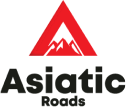
Any Question?
Feel free to call our travel experts.
+977 9851189018, +977 9801089018
info@asiaticroads.com
Date & Prices
| Start Date | End Date | Price | |
|---|---|---|---|
| November 17, 2023 | December 03, 2023 | 1400 USD | Book Now |
Whats Include and Exclude
Services Inclued
- All transfers, sightseeing tours & drives as per itinerary in a private tourist vehicle accompanied by Company representative.
- All guided sightseeing tour as per Itinerary in Kathmandu inclusive of applicable monumental fees.
- 3 nights stay at hotel (as above) in Kathmandu on twin sharing basis including American breakfast and all taxes.
- Nepali Welcoming Dinner at a Nepali authentic restaurant in Kathmandu.
- 11 nights / 12 days Everest Base Camp Trek inclusive of accommodation at teahouse lodges on sharing basis, all major meals (breakfast, lunch and dinner)
- Services of an experience English speaking Trek Leader, Sherpa assistant/s.
- Services of Reliable and strong porter/s (One for every two clients).
- Sagarmatha National Park & Pasang Lamu Rural Municipal development fees.
Services not Inclued
- International airfares and airport departure taxes.
- Nepal entry visa (US$ 50) per person for 30 days multiple entries.
- Airfare for sector Kathmandu / Lukla / Kathmandu (Quoted Seperately)
- Lunch and dinner except welcome and farewell dinner while staying at hotel in Kathmandu.
- Items of a personal nature such as; laundry, bar bills, alcoholic beverages (except on welcome dinner), extra mileage, optional tours such as Mountain Flights, telephone calls, internet services, personal gratuities as tips to guides, bell-hops or hotel porters, drivers, etc.
- Comprehensive Travel Insurance or “Umbrella Insurance” to cover – Illness, hospitalization, travel medicines, loss of valuables, thefts, change of itinerary, flight and tour cancellations due to unavoidable circumstances and most of all Emergency Helicopter Charter for evacuation purpose.
- Any items that are not mentioned in above the costs include section.
Other Costs (if Applicable)
| Particulars | Cost per person in US Dollars |
|---|---|
| Airfares for sector Kathmandu / Lukla / Kathmandu | US$ 360.00 net per person. |
Accomodations
Accomodation (Hotels envisaged or similar)
| Kathmandu | Hotel | 2 | BB |
|---|---|---|---|
| Phakding | Tea House | 1 | FB |
| Namche | Tea House | 2 | FB |
| Devouche | Tea House | 1 | FB |
| Dingboche | Tea House | 2 | FB |
| Lobuche | Tea House | 1 | FB |
| Gorakshep | Tea House | 1 | FB |
| Lobuche | Tea House | 1 | FB |
| Namche | Tea House | 1 | FB |
| Kathmandu | Hotel | 1 | BB |

Any Question?
Feel free to call our travel experts.
+977 9851189018, +977 9801089018
info@asiaticroads.com
Additional Information
-
Clothing & Equipments
WHAT TO WEAR:
Light clothing is only for short treks up to seven days at altitudes up to 6000ft (1830m) during fall (autumn) from September to November and in spring between March to May. The other months at all altitudes will be cold and at most times the temperatures will be below zero.
Footwear:
You will need hiking boots with ankle support, sneakers for flat trails, and flip-flops or chappals for use around the camp/lodge.
Clothes:
Shirts, T-shirts (4), blouse, etc., for daywear and a woolen shirt/T-shirts for evenings.
MEN:
Shorts, cotton trousers, jeans, sweatpants (recon-mended), etc.
Undergarments & Socks:
Thermal underwear and inner trousers for the above 7,000 ft. treks. Thick trek socks.
Warm Clothes:
A light sweater, a windcheater or light lined/padded jacket, and a down jacket or parka for above 7000 ft. treks. Woolen thick cap and warm gloves.
Sun / Rain:
Rain gear or umbrella and a sun hat are essential. Global warming has led to freak weather conditions and it has become more and more difficult to predict weather conditions.
Note: Umbrellas are cheap and easily available in Kathmandu.
HOW TO PACK
In The Day Pack: In the Duffel Bag: Sunglasses Towels Moisturizing/Sunscreen lotion Spare batteries Prescribed medicines Toiletries Flashlight washing soap Camera and spare film Spare clothes all wrapped in plastic bags Binoculars-optional Reading Reference book/Notebook Pencil/Pen / Water bottles/ Trek permits Toilet paper Umbrella/rain gear / Sweater Note: Sleeping bags can be purchased in Kathmandu. It is even available on hire upon request. However, we request our clients to bring their own sleeping bags because of hygiene.
-
General Notes About EBC Trek
- Flights in Kathmandu – Lukla sector are subject to weather conditions, so it is advisable that you should book your return international flight (refundable ticket) 2~3 days after your expected date of arrival in Kathmandu.
- Delays are expected on account of bad weather conditions. Our effort will be to continue with the tour as per the schedule and make you as comfortable as possible. But in such situations we may have to compromise on the guesthouse / hotels and adjust to these situations then and there.
- The Itinerary should be viewed as ideal and we may have to make some spot changes due to various reasons.
- The distances and altitude mentioned in the above itinerary are to the best of our knowledge and information; marginal variance in the actual distances and altitudes is possible.
-
Additional Information
-
Travel
Nepal is accessible by air and by road.
Air: Tribhuvan International Airport (Kathmandu) is the only international airport in Nepal.
Land: Political and weather conditions permitting, there are six main entry points into Nepal by land: five from India and one from China. There is also direct bus service between New Delhi (India) & Nepal.
-
Visa
Tribhuvan International Airport is the only international airport of Nepal. Immigration Office, TIA (Tribhuvan International Airport) under Department of Immigration has been facilitating tourists flying to Nepal by providing Visa on Arrival. ‘On Arrival’ visa procedure is very quick and simple. You can expect some queues during peak Tourist season. If you wish to skip those queues, you can also consider getting Visa from Nepalese Diplomatic Missions stationed abroad prior to your arrival. Choice is yours.
If you have obtained visa from Nepalese Diplomatic Missions, then you must enter Nepal within six months from the visa issued date. Your total stay is counted starting from the day you enter into Nepal.
Visas obtained on Arrival at the Entry and Exit points are ‘Tourist Visas’. They bear multiple Re-entry facility. Tourist Visa ‘On Arrival’ is the only entry visa to Nepal. If you are visiting Nepal for the purposes other than Tourism (sightseeing, tour, travel, mountaineering, trekking, visiting friends and families), you should still get ‘ Tourist Visa’ to get into the country. However, you must change the category of visa as per your purpose and length of stay in Nepal from Department of Immigration by producing required documents.
Please note citizens from Nigeria, Ghana, Zimbabwe, Swaziland, Cameroon, Somalia, Liberia, Ehhiopia, Iraq, Palestine, Afghanistan, Syria and Refugees with travel document are prohibited the on arrival via so you are to acquire Visa prior their arrival from their nearby Diplomatic missions (Embassies/consulates) of Nepal Government.
-
Visa fees
15 days multiple entries: US$ 30.00
30 days multiple entries: US$ 50.00
90 days multiple entries: US$ 90.00
-
Accommodation:
On the trek in Guesthouses:
Most of the guesthouses are basis and on twin / triple sharing basis with small neat and clean rooms and common toilets. The common toilets may be either inside the lodge or located outside the lodge and at times the cleanliness standards may be lower than those you normally expect. At higher altitudes the quality of these guesthous3es is not good.
-
Food:
- Food is provided from the kitchen of the same guesthouse. At higher altitudes the choice of food is limited.
- We will provide comical purified drinking water on trek. If you wish drink bottle or boiled water from Tea house lodge you have to pay for this directly.
- How shower facility is available on most of the lodges on extra cost. If you wish to have hot shower it will cost approximately Rs. 500 per shower (approximately US$5)
-
Fitness
The trek is strenuous and involves walking 6~7 hrs daily (more on few days). Previous walking experience on high altitude is helpful. The highest altitude that we attain on this tour is 5,416 m / 17,764 ft. We do not recommend this tour to people with chronic problems like epilepsy and those related to blood pressure or heart.
-
Baggage & Porters:
- Baggage allowance of 20kg (including hand carry) is permissible on Kathmandu – Pokhara – Kathmandu flight.
- Duffel Bag (Water proof).
- Sleeping bag & Down Jackets will be provided on a returnable basis on Request.
- The personal luggage along with sleeping, bag, down jacket should be packed in duffel bag or kit bag.
- Porters or mules will carry all personal luggages up to a maximum of 15 kg per person. Clients are expected to carry only a small rucksack while camera, pack lunch etc.
- If the client wishes to hire a porter so that he can walk along with the client, then an extra porter can be arranged on the spot for which the client must make an extra payment. The approximate cost for an extra porter will vary between $ 20 to $ 25 per day. We do not give a rider pony or yak to the clients.
-
Medical Help
This tour takes us through remote regions where professional medical help may not be available. We carry with us a comprehensive medical first ~ aid kit advised by doctor. Our tour leaders, though not qualified medically, are all competent to give first aid if and when required. It would be advisable to speak to your Tour leader in case of any health problems that you may face on the tour.
Any medical and evacuation expenses incurred for the client will have to be borne by that person only. (All the participants have to keep some contingency amount as a backup at home for this kind of emergency).
-
Temperature
Day temperatures average between 10 degree C to 20 degree C and night time temperatures can drop to below 5 degree further to below 0 degree in different altitude.
-
-
How To Train For Trekking
Many people worry that they are not fit enough for long treks, especially in the challenging Himalayan region. However with the right training realistic expectations, and healthy on-trail habits, Himalayan treks is possible for most of healthy hikers. Here are some tips for how to train for trekking in the Himalayas.
START EARLY
You will need to build muscle, endurance and your cardiovascular system. Do no put of training until a month before you leave. It is worth splurging a bit and hiring a trainer who can design a program specifically for what you are doing. If he or she can see you’re hiking Itinerary, even better. They will likely develop a plan that spans several months. Stick with it.
USE A COMBINATION OF EXERCISES
If you choose to develop you own plan (after careful research), use a variety of exercises. Including trail running ensures you will be confident on your feet on uneven terrain. You will also want to include box steps on boxes of varying heights while holding weights. Though you need to build strength to hike 4 to 9 or 10 hours in a day, it is also worthwhile to include sprint intervals, either running or on a bike. This improves your recovery time. Try short bursts of pushing a heavy sled to build your CV system to ensure you don’t feel like throwing up on the trail!! And do not forget your Arms! You should use your trekking poles, and these may give you more of a forearm workout tan you anticipate. Try some triceps extensions, as well as pull ups, rows and dips for your shoulders and back. You will, after all, be carrying a day pack.
STAYING HEALTHY ON TREK
Water is most important part of your hike. Drink at least 3/4 liters of water a day. Ensure yourself you are rehydrating all the time (Dehydration is one of the reason of Acute Mountain Sickness) . Stretch your calves, hips and gluteus any time you stop. This will minimize morning soreness and prevent injury. Bring bio freeze, icy hot, or Tiger Balm for rubbing on sore muscles at night (Tiger Balm is easily available in Kathmandu & Pokhara); these are practically helpful on and behind my knees after steep down hills. No matter what your diet is at your home, eat on a trail. All the teahouses serve pasta, rice, and pizza. Take an advantage of all those carbs. Avoid having alcoholic liquor especially while going up in the High Altitude.
WHEN YOU FINISH
The work you have done hiking will affect you even particularly painful, as your legs may be very restless for several days. Wear compression socks and try to get an aisle seat so you can walk around. After all this, you will definitely come away with a sense of exactly how strong your body is.
-
Notes For Trekkers / Travellers
Dear Guests,
Namaste & warm Greetings from Nepal!!We are very pleased that you have inquired for your trek with Asiatic Roads. The idea of this hand out is to furnish you with information for your pre-trek preparations.
Firstly, we recommend that you travel light. A good-sized duffel bag with a top length zipper that can lock is best, together with a day pack for carrying personal items on the trek. An extra smaller bag would be handy to carry back your souvenirs after the trip.
AFTER ARRIVAL IN KATHMANDU
1. TREK BRIEFING:
On your arrival in Kathmandu, we will arrange to meet for a pre-trek briefing. Full information on all aspects of your trek, questions and doubts will be discussed. On trek your Sherpa leader (sardar) will give you more details about the route, villages, people and other information regarding the trek.2. PACKING:
You may leave behind part of your luggage in your hotel or our locker room before the trek, in Kathmandu. All baggage is to be clearly marked and locked. Kindly refrain from carrying or wearing valuables on the trek. You may leave them behind at the safety deposit box at your hotel or with us.3. HOW TO PACK:
Your clothes and equipment should fall into the following 4 categories:1. What you are going to leave behind in Kathmandu.
2. What you are going to wear on the trail.
3. What you are going to carry in your day pack.
4. What you would like the porters to carry for you.Excess clothes and luggage can be stored in your hotel’s storeroom, and valuables in the safety deposit box. Please label your luggage and make sure to take a receipt from the front desk of your hotel for all the things you would like to leave behind while you are away.
ON TREK
1. YOUR STAFF ON THE TRIP:
Will consist of one English speaking Sirdar (Guide) and Assistance Guide or Escort who will be wholly responsible for the execution of the trip once it hits the trail. He will be assisted by Sherpa(s) as necessary.2. WHAT TO CARRY DURING THE TREK:
Your daypack, preferably waterproof should be light, small and comfortable. All small personal items like toilet paper, water bottle, medicines, extra shirt, light warm wears, rain gear, gloves etc. that may be needed for the days trek should be packed. Your duffel will be carried by porters who may not be with you at all times.3. MONEY ON TREK:
You may want to buy drinks at wayside shops and souvenirs from the natives. Small change should be carried. As customary, we can help discuss in detail in the pre-trek briefing.TREK KIT LIST
WHAT TO WEAR:
Light clothing are only for short treks up to seven days at altitudes up to 6000ft (1830m) during fall (autumn) from September to November and in spring between March to May. The other months at all altitudes will be cold and at most times the temperatures will be below zero.Footwear:
You will need hiking boots with ankle support, sneakers for flat trails and flip-flops or chappals for use around the camp/lodge.Clothes:
Shirts, T-shirts (4), blouse, etc., for daywear and a woolen shirt/T-shirts for evenings.MEN: Shorts, cotton trousers, jeans, sweat pant (recon-mended) etc.
Undergarments & Socks:
Thermal underwear and inner trouser for the above 7,000 ft. treks. Thick trek socks.Warm Clothes:
A light sweater, a windcheater or light lined/padded jacket and down jacket or parka for above 7000 ft. treks. Woolen thick cap and warm gloves.Sun / Rain:
Rain gear or umbrella and a sun hat is essential. Global warming has led to freak weather conditions and it has become more and more difficult to predict weather conditions.
Note: Umbrellas are cheap and easily available in Kathmandu.HOW TO PACK
In The Day Pack: In the Duffel Bag:
Sun glasses Towels
Moisturizing/Sun screen lotion Spare batteries
Prescribed medicines Toiletries
Flash light washing soap
Camera and spare film Spare clothes all wrapped in plastic bags
Binoculars-optional
Reading Reference book/Note book
Pencil/Pen / Water bottles/ Trek permits
Toilet paper
Umbrella/rain gear / SweaterNote: Sleeping bags can be purchased in Kathmandu. It is even available on hire upon request. However, we request our clients to bring their own sleeping bags because of hygiene.
ADDITIONAL ITEMS:
For most treks from mid-November till mid-February and for those above 10,000 ft. /3000 m., in Spring and Autumn, anti-dazzle glasses or goggles with side attachments are recommended and High altitude food supplements (favorite snacks) if necessary.IMPORTANT NOTE:
In the event of an accident or serious ailment on a trek, helicopter evacuation can be arranged. The helicopter fare with 10% service charge and the hospital/medical charge will have to be cleared before departing from Kathmandu. A risk, release and guarantee form has to be signed before leaving on a trek with us.INSURANCE:
There are no reliable medical insurance policies in Nepal for foreigners. We strongly recommend you to take comprehensive holiday insurance in your own country covering adventures involving some elements of risk, especially to cover Emergency Helicopter Evacuation.BOOKS:
Trekking in the Nepal Himalayas by Stan Armington published by the Lonely Planets books provides you comprehensive information on all matters regarding trekking in Nepal
The Trekkers Peaks of Nepal by Bill O’Connor published by Crow Wood press in U.K. provides you with information on all matters regarding climbing peaks in Nepal.
Trekking in Nepal by Toru Nakano published by Allied Publishers gives you some insight into some important trekking areas in Nepal. A map of Nepal is enclosed in the book. -
Notes On Acute Mountain Sickness
Key to acclimatization: Is adequate hydration, adequate nutrition & managing personal comfort through adequate layers lead to acclimatization.
Following extracts are taken from “The Wilderness First Responder” by Buck Tilton, director of Wilderness Medicine Institute of NOLS, USA
Dehydration
Without water there would be no life – at least no life, as you know it…
Water puddles inside every one of your cells, and flows through the microscopic spaces between cells. In water, oxygen and nutrients float to all parts of your body, and waste products are carried away. When your kidneys remove waste from your body those wastes have to be dissolved in water. Digestion and metabolism are water-based processes, and water is the primary lubricating element in your joints. You even need water to breathe, your lungs requiring moisture to expedite the transfer of oxygen into blood and carbon dioxide out of blood. Sweat, as mentioned, is mostly water. The water in your blood carries heat from warmer body parts to cooler areas of your anatomy when you are exposed to cold. In short, if aren’t well hydrated, you won’t be able to stay healthy, maximize your performance, or even maintain joy at being outdoors.
The water in your body, the fluid that keeps you alive and active, leaves you at an alarming rate. Estimates vary widely, but an average person at rest on a normal day loses between two and three liters of water. One to one-and-a-half liters rushes out as urine, and another one-tenth liter in defecation. Moisture is lost from act of breathing, more than half a liter per day, and that rate increases in dry winter air.
Then there’s sweat. The fluid lost in perspiration can climb to one to two liters per hour during periods of strenuous exercise. Compared to watching TV all day, one hour of exercise may demand approximately a 50 percent increase in the amount of water your body uses.
Your thirst mechanism that feeling of ”Gosh, I need a drink of water”, doesn’t kick in until you’re about one to one-and-a-half liters low. Down three to four liters can leave your endurance decreased to 50 percent and your oxygen uptake reduced close to 25 percent…
Acclimatization
The medical problems collectively referred to, as “altitude illnesses” is the result of hypoxia, insufficient oxygen in the blood for normal tissue function, a result of the decreased barometric pressure at higher altitudes. When you go up, the barometric pressure goes down, the concentration of oxygen in the air decreases, and the chance of altitude illness climbs.
Since there is a measurable increase in ventilation and decrease in aerobic exercise performance above 4,000 feet elevation, “high altitude” can be said to start at that point. Complications seldom occur, however, below 8,000 feet. In defining terms, consider 8,000 to 12,000 feet as high altitude, 12,000 to 18,000 as very high altitude, and 18,000 plus as extreme high altitude.
The human body will adjust to dramatic changes in barometric pressure, given enough time. Altitude illnesses – which range from mildly disturbing to completely fatal – are determined, primarily, by three factors:
How high the patient goes.
- How fast the patient attains a specific altitude, and
- Predisposing factors such as genetics and previous upper respiratory illnesses.
- Critical to acclimatization is adequate hydration and nutrition.
PREVENTION:
As mentioned earlier, most people will adjust to altitude given enough time. Staged ascent is the key to acclimatization and, therefore, the key to preventing altitude illnesses.
Adequate hydration is critical to the prevention of altitude illnesses. You should drink enough water to keep your urine output clear and copious.
A high calorie diet is essential for the energy needed to ascend and acclimatize.
Avoid respiratory depressants, such as sleeping pills and alcohol.
…But physical fitness prior to ascent is a bonus in the game of safety and enjoyment. Fitness does not, however, protect against acute mountain sickness.
(Friends: this is just to inform you about these important factors that we would be dealing in on the mountain. I know that there would be a lot of questions in your mind – how does one acclimatize, what food is to be taken, what are the early signs and symptoms that would alert me to start taking extra efforts to stay hydrated/acclimatized, etc. etc.)

Any Question?
Feel free to call our travel experts.
+977 9851189018, +977 9801089018
info@asiaticroads.com
Reviews
In my 2 week stay, John was very professional and took me around to experience all that Kathmandu and surrounding areas has to offer. Sites were seen and many locals were met through John’s network.

Steven Stone
TravellerIn my 2 week stay, John was very professional and took me around to experience all that Kathmandu and surrounding areas has to offer. Sites were seen and many locals were met through John’s network.

Steven Stone
Traveller
